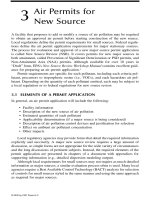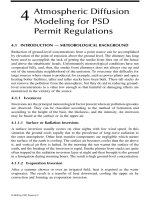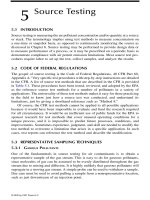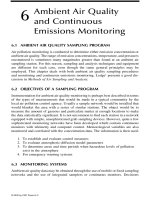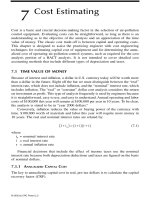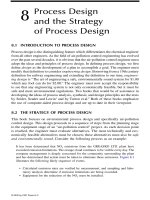AIR POLLUTION CONTROL EQUIPMENT SELECTION GUIDE - CHAPTER 14 ppt
Bạn đang xem bản rút gọn của tài liệu. Xem và tải ngay bản đầy đủ của tài liệu tại đây (788.49 KB, 7 trang )
© 2002 by CRC Press LLC
chapter 14
Spray towers/scrubbers
Device type
Spray tower scrubbers use spray nozzles to extend the surface area of the
scrubbing liquid to enhance mass transfer of contaminant gas(es) into the
liquid. They are primarily used for gas absorption.
Spray scrubbers include designs that use spray nozzles (hydraulically
or air or steam atomized) to absorb gases and control particulate.
Typical applications and uses
Spray tower scrubbers are often used on wet flue gas desulfurization (FGD)
systems at public and industrial power generation facilities. These FGD
systems use lime or limestone slurries as the scrubbing liquid. Their open
vessel design is an advantage where plugging or scaling may occur. The
simplicity of the design makes them a lower cost alternate for high gas
volume scrubbing applications (over 100,000 acfm).
They are also used as part of quenching and gas conditioning systems
wherein the gas must be brought to saturation or near saturation with water.
Most spray towers are countercurrent in design wherein the gas flows
vertically upward and the liquid falls downward through the ascending
gases. Some units, used for odor control, are horizontally oriented using a
multiplicity of concurrent spray sections in series.
Spray scrubbers cover a wider variety of designs. These vary from
devices as simple as a spray header in a duct to cyclonic type devices (often
called preformed spray scrubbers).
Operating principles
A common characteristic of this type scrubber is the use of spray nozzles to
extend the liquid surface and produce target droplets.
At least one spray zone is produced in a spray tower using at least one
spray nozzle in a containing vessel. In practice, however, most spray towers
© 2002 by CRC Press LLC
use multiple spray zones to achieve the required gas cleaning efficiency.
Figure 14.1 shows a sectional view of a spray tower. The gas inlet is typically
horizontally oriented into the containing vessel. A multiplicity of spray zones
is used, each containing an array of nozzles. In FGD applications, these
nozzles are wear-resistant designs (such as silicon carbide) since the scrub-
bing liquid is an abrasive slurry of lime or limestone.
The hydraulic pressure applied to the liquid acts as stored energy. When
this pressurized liquid flashes from the spray nozzle, the energy stored is
expended in producing a spray. The high relative velocity between the liquid
and surrounding gas causes a shearing action that breaks the liquid into tiny
droplets. The net effect is that the liquid surface area increased so that the
contaminant gas or gases can be more readily absorbed.
After the spray is produced, the contaminant gas is absorbed through
the liquid film. If a reactive chemical is contained in the droplet, the con-
taminant will react, forming a byproduct (usually a salt) of lower vapor
pressure. Therefore, the contaminant remains in the droplet.
Most droplets fall by gravity in counter-flow designs to the sump. Quite
often, the scrubber is mounted directly over the sump to facilitate this sep-
aration. A small portion of the spray goes overhead with the gas. This droplet
dispersion is controlled using chevron type droplet eliminator(s) in the case
of a gas stream containing particulate, or mesh pads if the gas stream is low
in or devoid of particulate. The chevron droplet eliminators are often sprayed
constantly from below and on timer basis from above for cleaning purposes.
Figure 14.1
Spray tower sectional view.
Chevrons
Chevron
sprays
Spray
zones
Retention
sump
Gas
inlet
Pump
SPRAY TOWER
© 2002 by CRC Press LLC
Figure 14.2 shows a common application where a utility FGD spray
tower is installed after a dry precipitator used for particulate control.
With the preformed spray scrubber, the spray nozzles are generally
installed in the gas inlet area of essentially a cyclonic separator. The spray
dispersion is very intense and dense in the inlet zone. The gas is accelerated
as the gas approaches the tangent point of the separator vessel. This action
enhances particulate capture. The droplets are then spun from the gas stream
using centrifugal force. Figure 14.3 shows a sketch of a preformed spray
scrubber in elevation and plan view. Note how the gas inlet curves around
the cylindrical separator vessel. This curved portion is called an involute
and may extend from 90 to 270 degrees of vessel circumference. Note also
that the sprays are mounted on individual headers on the involute for
simplified access. These headers usually are connected to a distribution pipe
by hoses and are isolated by valves so that individual headers may be
removed for servicing.
A preformed spray scrubber was used on the superphosphate fertilizer
multistage scrubber application referenced in previous chapters. It forms the
base of the stack as shown in the center of Figure 14.4. It was used to remove
residual fluoride compounds and to concentrate the fluosilicic acid prior to
the solution being sent to the filament/mesh pad scrubber (to the left) for
further concentration. The fluosilicic acid recovery tanks are to the right of
the picture.
Primary mechanisms used
The primary scrubbing mechanism used in a spray tower is absorption. To
some extent, diffusion is in play as the contaminant gas moves towards the
droplet surface. The droplets themselves can remove some particulate by
impaction; however, the relative velocity between the gas and liquid is low
(usually below 20–40 ft/sec), so impaction is minor.
Figure 14.2
Utility FGD system (Babcock & Wilcox Company).
© 2002 by CRC Press LLC
Figure 14.3
Preformed spray scrubber (Bionomic Industries Inc.).
Figure 14.4
Preformed spray scrubber on superphosphate dryer (Bionomic In-
dustries Inc.).
UNIT
UNIT
© 2002 by CRC Press LLC
Spray scrubbers using cyclonic action do apply impaction and inter-
ception forces to the gas stream and therefore exhibit higher particulate
removal rates.
Design basics
Gas inlet velocities of spray towers are in the range of 50 to 60 ft/sec as is
common with other wet scrubbing systems. Sometimes, for gas distribution
purposes, the gas is conveyed to the scrubber at this velocity to keep par-
ticulate entrained but is reduced to 40 to 45 ft/sec at the scrubber itself.
Counter-current spray towers normally operate at vertical gas veloci-
ties of 8 to 10 ft/sec; however, in recent years efforts have been made to
operate them at up to 15 ft/sec. At approximately 15 to 16 ft/sec gas
velocity, the descending spray tends to be held up or fluidize. At this point,
the spray tower begins to transition to a fluidized bed scrubber. The spray
nozzle method of liquid injection becomes of diminishing importance as
the gas velocity rises since the spray is actually created by the ascending
gas at these speeds.
The chevron zones of these designs usually use a face (open vessel)
velocity of approximately 10 to 12 ft/sec. Interface trays, much like weeping
sieve trays, are used in some designs to suppress liquid carry over and isolate
the dilute wash water spray that is applied to clean the chevrons.
If a top mounted stack is used, the gas outlet velocity will be often
under 45 ft/sec to reduce the chance of entrainment. Speeds of 35 to 45
ft/sec are common.
For FGD systems, the pH (and sometimes, density) of the scrubbing
solution is controlled to operate within a window bounded by efficiency and
scaling. For limestone slurry scrubbing, this results in a pH range of approx-
imately 5.6 to 6.5 in the slurry and 5.4 to 6.2 in the sump. For lime, the slurry
is approximately pH 7 to 8 going into the absorber and 5 to 5.5 in the sump.
Nozzle pressures of 30 to 60 psig are used, depending on the application.
Given that the liquid surface area of a spray decreases as the distance
from the nozzle increases, high liquid to gas (L/G) ratios are used, that is,
using multiple nozzles, to maintain the net surface area at a sufficiently high
level. As a result, it is not uncommon to see L/G ratios of 50 to 100 gpm/1000
acfm treated being used in these designs. The pumping cost, therefore,
becomes a significant design factor.
Given the open area of the vessel, however, the gas side pressure drop
is quite low. Spray towers operate at pressure drops of only 1 to 3 inches
water column. This keeps the fan horsepower low. This factor is significant
for high gas volume applications.
Spray towers of more than 30 ft diameter have been built. The simple
vessel design allows these large diameter vessels to be made. For high gas
volumes, multiple towers are used in parallel. On utility boiler systems,
redundancy is often built-in by having the capability to switch between
operating and standby vessels using suitable isolation dampers.
© 2002 by CRC Press LLC
Operating suggestions
Over the past 40 years, operators of spray towers have developed specific
methods for the best operation of these devices.
Some basic techniques include separation of solids that would be suffi-
ciently large to plug the spray nozzles. Settling tanks, liquid cyclones are
often used to separate the large solids. The nozzles themselves are designed
for high solids throughput and wear resistance. Often of full cone design,
the nozzles are arranged in patterns that cover the vessel but reduce zones
where agglomeration of droplets (resulting in an undesirable reduction of
surface area per unit volume) can occur. Multiple spray levels increase the
probability that all zones are covered.
Once absorption occurs, the chemical reaction kinetics in the liquid may
be slow. In FGD systems, the scrubbing liquid is often impounded in an
agitated tank to allow crystal formation and settling. Residual crystals are
allowed to recycle to help scour the scrubber interior and reduce hard scaling.
Sometimes, chemical additives (such as adipic acid) are administered to
improve the scrubbing performance. Oxygen is sometimes injected to oxidize
the sulfite component of the scrubbing solution to sulfate so that the sulfate
may be more easily settled and removed.
For materials of construction, the vessels are often mild steel with rubber
lining for utility FGD application. If chlorides are present, alloys such as
904L, AL6XN, C-22, or C-276 are used.
Chevrons in many FGD designs are installed in stages given the high
droplet loading. A coarse stage of widely spaced blades is used followed by
narrower spaced chevrons either in vertical flow or horizontal flow config-
uration. Figure 14.5 shows a chevron set using multiple design configura-
tions to arrest the spray.
Spray scrubbers have been made in a wide variety of materials from
carbon steel, to rubber-lined steel, to FRP, to exotic alloys. Some designs have
Figure 14.5
Multiple chevron stages (Munters Corp.).
© 2002 by CRC Press LLC
even received food grade interior polishing to handle explosive type mate-
rial. Preformed spray scrubbers usually are equipped with retractable spray
headers and individual shut-off valves for nozzle servicing. Obviously, one
must plan for sufficient pull space to remove such headers.
If large solids are anticipated that could plug the nozzles, strainers on
the recirculation loop should be used. It is also advised to locate any vessel
access door such that the worker can gain entrance to the scrubber easily. A
common location is directly over the separator inlet duct.
Preformed spray scrubbers perform like Venturi scrubbers operating at
6 to 10 inches water column pressure drop. This means they are best suited
for the control of particulate above 10
µ
m aerodynamic diameter. For gas
absorption, an inlet spray type unit can achieve about 0.8 to 1.5 transfer units
of separation. Ones with wall mounted sprays can often achieve higher mass
transfer rates, but are more likely to entrain droplets.
Spray towers and spray scrubbers are popular devices for use in gas
absorption applications and, in the case of preformed spray scrubbers, for
particulate control on particles in excess of 10
µ
m diameter.




